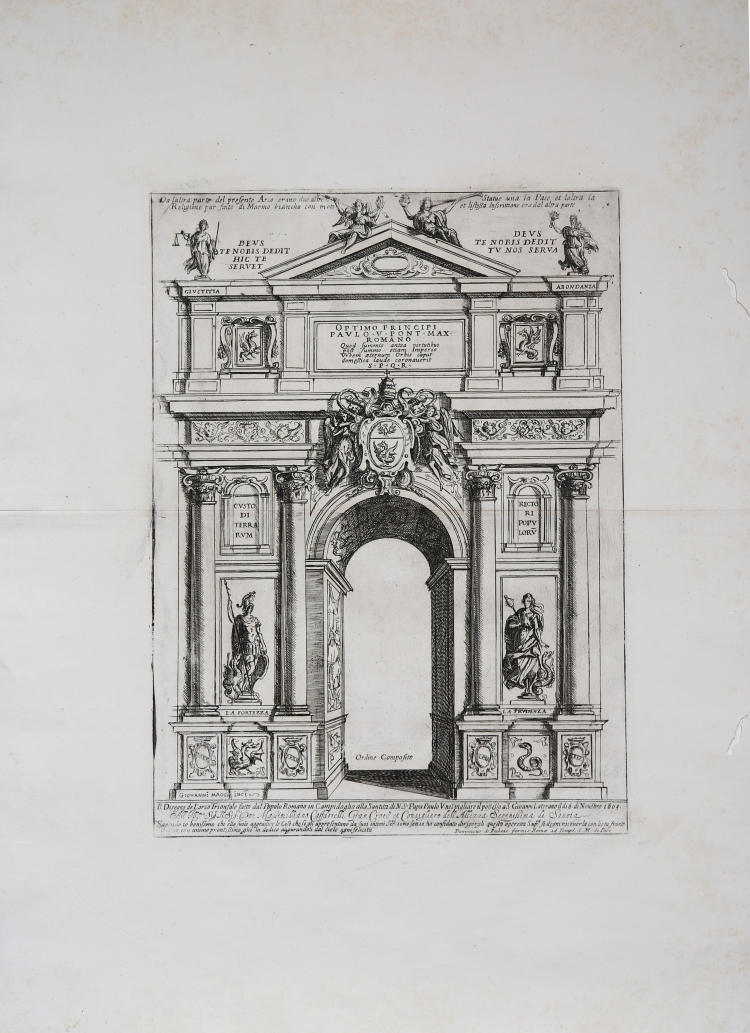- New




| Reference: | S52135 |
| Author | Giovanni MAGGI |
| Year: | 1605 |
| Printed: | Rome |
| Measures: | 280 x 385 mm |



| Reference: | S52135 |
| Author | Giovanni MAGGI |
| Year: | 1605 |
| Printed: | Rome |
| Measures: | 280 x 385 mm |
Il disegno de l’Arco Trionfale fatto da Popolo Romano in Campidoglio alla Santità di N.S. Papa Paulo V nel pigliare il possesso a S.Giovanni Laterano il 6 di Novembre 1605/ All’Ill.mo Sig.re Don Massimiliano Caffarelli Gran Croce et Consigliere dell’Altezza Serenissima di Savoia/Sapendo io benissimo che ella suole aggradire le Cose che se gli rappresentano da suoi intimi Servi come son io, ho confidato dirigergli questa operetta Sup:ca si degni riceverla con lieta fronte/come io con animo prontissimo glie la dedico augurandogli dal cielo ogni felicità. Dominicis De Rubeis formis Romae ad templ. S.M. de Pace.
Etching, 1605, signed lower left Giovanni Maggi inc.
It depicts the arch erected on the Capitoline Hill on the occasion of the cavalcade of Possesso of Pope Paul V, born Camillo Borghese (1552-1621), which took place on May 16, 1605. Engraved by Giovanni Maggi from a drawing by Antonio Tempesta (see Thieme-Becker, vol. XXXII, pp. 516-517), it is dedicated to Massimiliano Caffarelli, ambassador of the House of Savoy in Rome.
The arch is very ornate: it is double-sided with four columns and niches with two statues on each side, symbolizing, respectively, Fortitude, Prudence, Peace, and Charity. We know that three other ephemeral structures were erected on the same occasion: in Banchi, in front of the Church of the Gesù, and the Roman College.
The Possession ceremony refers to the processional procession that carries the newly elected pontiff, Bishop of Rome, from St. Peter's to his chair, the Basilica of St. John Lateran—"Mother and Head of All the Churches of the City and the World." It was marked by four phases: the pontiff's exit (exitus) from the Apostolic Palace or, starting in 1724 (by order of Benedict XIII), from the Quirinal Palace; the symbolic ascent (adscensus) to the Capitoline Hill where the Pope was paid homage by the Senate of Rome; the descent (descensio) into the Roman Forum, which continued along the Via Sacra and the Arches of Titus and Constantine; and finally the arrival (adventus) and entrance (introitus) into the Lateran Basilica. An impressive procession consisting of the entire papal court, bishops, cardinals, representatives of the city's institutions, families of the lay and ecclesiastical nobility, as well as guards and standard-bearers followed the pontiff, some on foot and some on horseback.
The Renaissance pontiffs were responsible for transforming the ceremony into a "triumphus," a clear reference to the triumphs of Imperial Rome. This is why the procession passed in front of the buildings of ancient Rome, particularly the triumphal arches, which had great symbolic value: they immediately recall the continuity between Imperial Rome and the Rome of the Popes, between ancient triumphs and modern triumphs, and therefore the legitimacy of the spiritual and political power of the pontiffs.
Not only did the cavalcade pass under existing arches, but temporary or ephemeral ones were also built in wood, stucco, and papier-mâché. These were concentrated in the Triumphal Arch on the Capitoline Hill, starting in the last decade of the 16th century, and in the Roman Forum, towards the mid-17th century, creating an ideal link between ancient and modern triumphs.
A magnificent work, printed on contemporary laid paper, with margins, two wormholes in the right white margin, otherwise in excellent condition. Rare.
Bibliografia
Fagiolo dell’Arco, pp. 207-208; Il Museo di Roma racconta la città, p. 92.
|
Painter and etcher. Active in Rome. He appears in 1605 in the Libro del Camerlengo of the Compagnia di S.Luca, Rome, in a list of those who have contributed ‘per lemosina dela candela’. He applied for admission to the Virtuosi del Pantheon, 9 January 1611.
1609 entered into a working agreement with Giovanni Orlandi at the Pasquino-engraved various churches for him.Plates listed in the Vaccari stocklist of 1614.
Important as an etcher of landscape.Also antiquities,including series:Libro di tutte le guglie,1600,and the ornamenti delle fabbriche antiche e moderne dell’alma città di Rome,1600.
Map of Rome, 1603. 1604 Bichierografia, commissioned from him c.1600 by Cardinale Del Monte.
|
|
Painter and etcher. Active in Rome. He appears in 1605 in the Libro del Camerlengo of the Compagnia di S.Luca, Rome, in a list of those who have contributed ‘per lemosina dela candela’. He applied for admission to the Virtuosi del Pantheon, 9 January 1611.
1609 entered into a working agreement with Giovanni Orlandi at the Pasquino-engraved various churches for him.Plates listed in the Vaccari stocklist of 1614.
Important as an etcher of landscape.Also antiquities,including series:Libro di tutte le guglie,1600,and the ornamenti delle fabbriche antiche e moderne dell’alma città di Rome,1600.
Map of Rome, 1603. 1604 Bichierografia, commissioned from him c.1600 by Cardinale Del Monte.
|